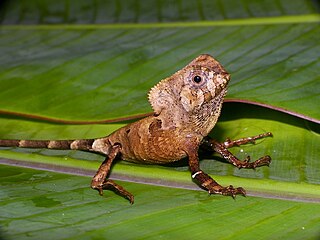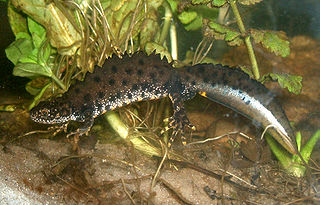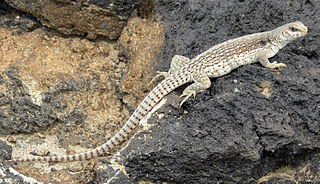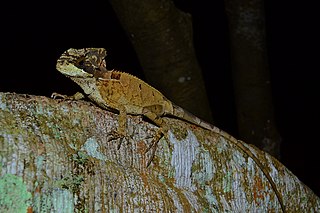
Lizard is the common name used for all squamate reptiles other than snakes, encompassing over 7,000 species, ranging across all continents except Antarctica, as well as most oceanic island chains. The grouping is paraphyletic as some lizards are more closely related to snakes than they are to other lizards. Lizards range in size from chameleons and geckos a few centimeters long to the 3-meter-long Komodo dragon.

Corytophanidae is a family of iguanian lizards, also called casquehead lizards or helmeted lizards, endemic to the New World. Nine species of casquehead lizards from three genera are recognized.

The plumed basilisk, also called the green basilisk, double crested basilisk, or Jesus Christ lizard, is a species of lizard in the family Corytophanidae. The species is native to Central America.

Corytophanes is a genus of Neotropical lizards, commonly called helmeted iguanas or basilisks, in the family Corytophanidae. The genus contains three arboreal species and resides in tropical forests.

The northern crested newt, great crested newt or warty newt is a newt species native to Great Britain, northern and central continental Europe and parts of Western Siberia. It is a large newt, with females growing up to 16 cm (6.3 in) long. Its back and sides are dark brown, while the belly is yellow to orange with dark blotches. Males develop a conspicuous jagged crest on their back and tail during the breeding season.

The common basilisk is a species of lizard in the family Corytophanidae. The species is endemic to Central America and South America, where it is found near rivers and streams in rainforests. It is also known as the Jesus Christ lizard, Jesus lizard, South American Jesus lizard, or lagarto de Jesus Cristo for its ability to run on the surface of water.

The desert iguana is an iguana species found in the Sonoran and Mojave Deserts of the Southwestern United States and northwestern Mexico, as well as on several Gulf of California islands.

The marine iguana, also known as the sea iguana, saltwater iguana, or Galápagos marine iguana, is a species of iguana found only on the Galápagos Islands (Ecuador). Unique among modern lizards, it is a marine reptile that has the ability to forage in the sea for algae, which makes up almost all of its diet. Marine iguanas are the only extant lizard that spends time in a marine environment. Large males are able to dive to find this food source, while females and smaller males feed during low tide in the intertidal zone. They mainly live in colonies on rocky shores where they bask after visiting the relatively cold water or intertidal zone, but can also be seen in marshes, mangrove swamps and beaches. Large males defend territories for a short period, but smaller males have other breeding strategies. After mating, the female digs a nest hole in the soil where she lays her eggs, leaving them to hatch on their own a few months later.

The rhinoceros iguana is an endangered species of iguana that is endemic to the Caribbean island of Hispaniola and its surrounding islands. A large lizard, they vary in length from 60 to 136 centimetres, and skin colours range from a steely grey to a dark green and even brown. Their name derives from the bony-plated pseudo-horn or outgrowth which resembles the horn of a rhinoceros on the iguana's snout. It is known to coexist with the Ricord's iguana ; the two species are the only taxa of rock iguana to do so.

The Fiji crested iguana or Fijian crested iguana is a critically endangered species of iguana native to some of the northwestern islands of the Fijiian archipelago, where it is found in dry forest on Yaduataba, Yadua, Macuata, Yaquaga, Devuilau, Malolo, Monu and Monuriki.

The Guatemalan helmeted basilisk is a species of lizard in the family Corytophanidae. The species is native to Central America and southern Mexico.

Enyalioides laticeps, the Amazon broad-headed wood lizard, is a dwarf iguanian lizard abundantly found in Amazonian rainforests. They are semi-arboreal and mostly live in forests. Other names for it include broad-headed wood lizards, Big-headed stick lizards, Guichenot's Dwarf Iguana, Amazon Forest Dragon, or Amazon Dwarf-Iguana.
Henry Carl Aldrich was an American mycologist born in Beaumont, Texas.
Babibasiliscus is an extinct genus of casquehead lizard that lived in what is now Wyoming during the early Eocene, approximately 48 million years ago. The genus is known from a single species, Babibasiliscus alxi, which was named by paleontologist Jack Conrad in 2015 on the basis of a fossilized skull from the Bridger Formation in the Green River Basin. The name Babibasiliscus comes from the Shoshoni word babi, meaning "older male cousin", and Basiliscus, a modern-day genus of casquehead lizards. The specimen is undeformed and nearly complete except for the tip of the snout and the top of the skull, making it unclear whether the distinctive bony crest of living corytophanids was present in prehistoric relatives like Babibasiliscus. The skull is about 42 millimetres (2 in) in length and the entire body is estimated to have been about 0.6 metres (2 ft) long. Bones on the right side of lower jaw of the specimen are thickened and fused together, suggesting that the jaw had broken and healed when the animal was alive.

A casque is an anatomical feature found in some species of birds, reptiles, and amphibians. In birds, it is an enlargement of the bones of the upper mandible or the skull, either on the front of the face, or the top of the head, or both. The casque has been hypothesized to serve as a visual cue to a bird's sex, state of maturity, or social status; as reinforcement to the beak's structure; or as a resonance chamber, enhancing calls. In addition, they may be used in combat with other members of the same species, in the gathering of food, or in thermoregulation.

Corytophanes hernandesii, also known commonly as Hernandez's helmeted basilisk and el turipache de montaña in Spanish, is a species of lizard in the family Corytophanidae. The species is native to Central America and southern Mexico.

Laemanctus serratus, also known commonly as the serrated casquehead iguana, is a species of lizard in the family Corytophanidae. The species is native to southeastern Mexico and Central America. There are two recognized subspecies.
















